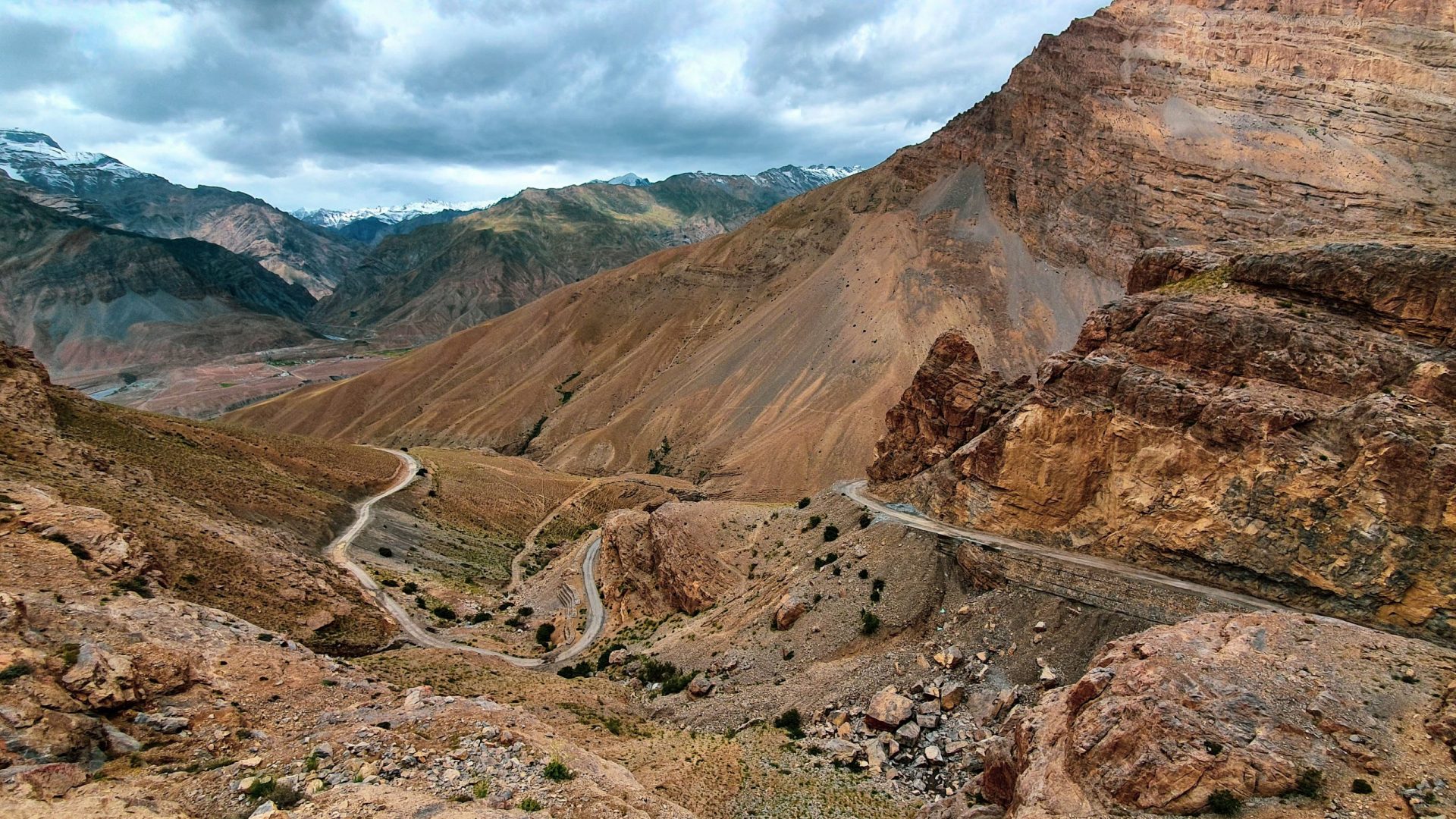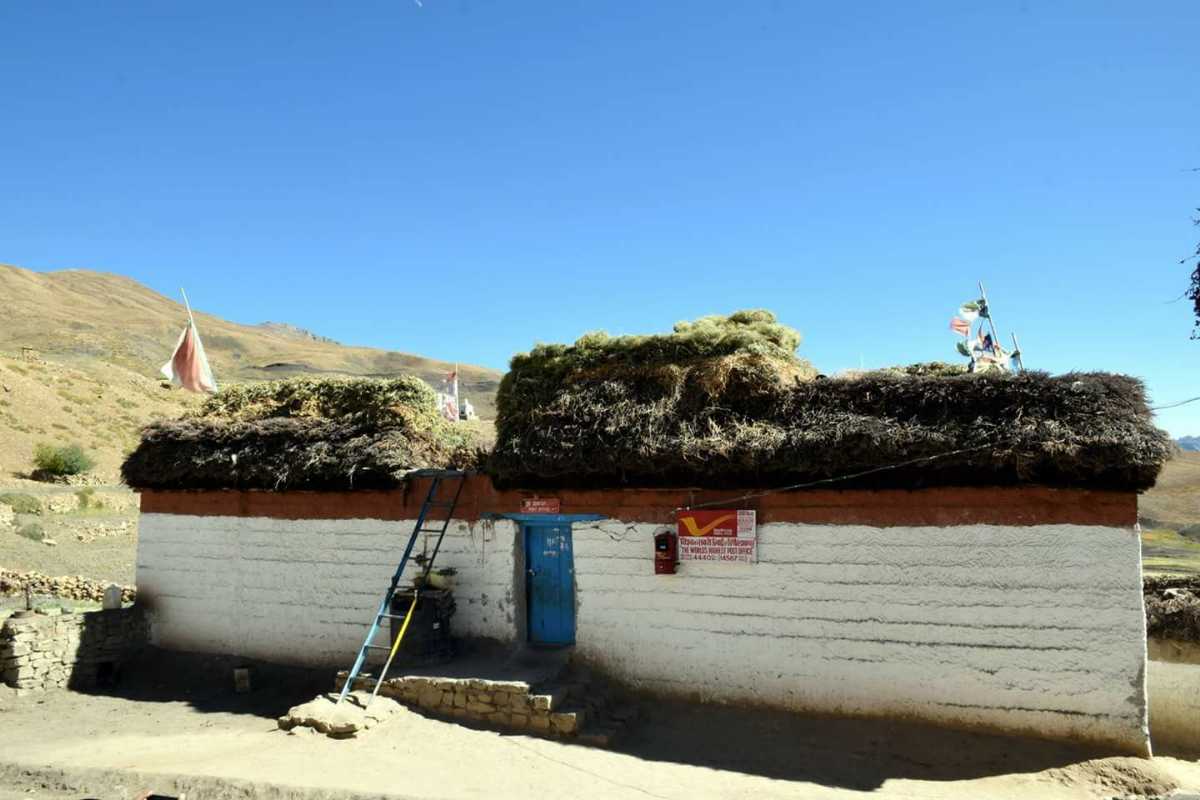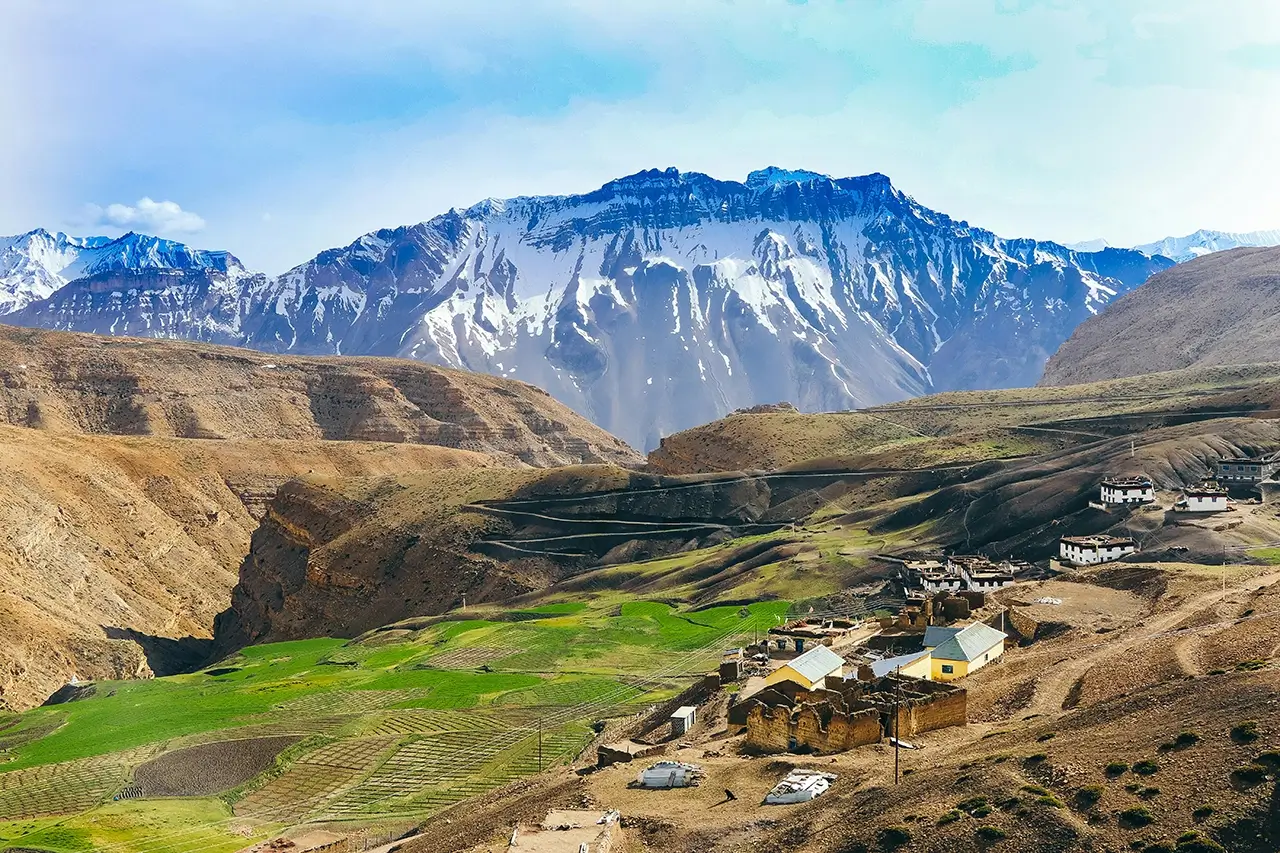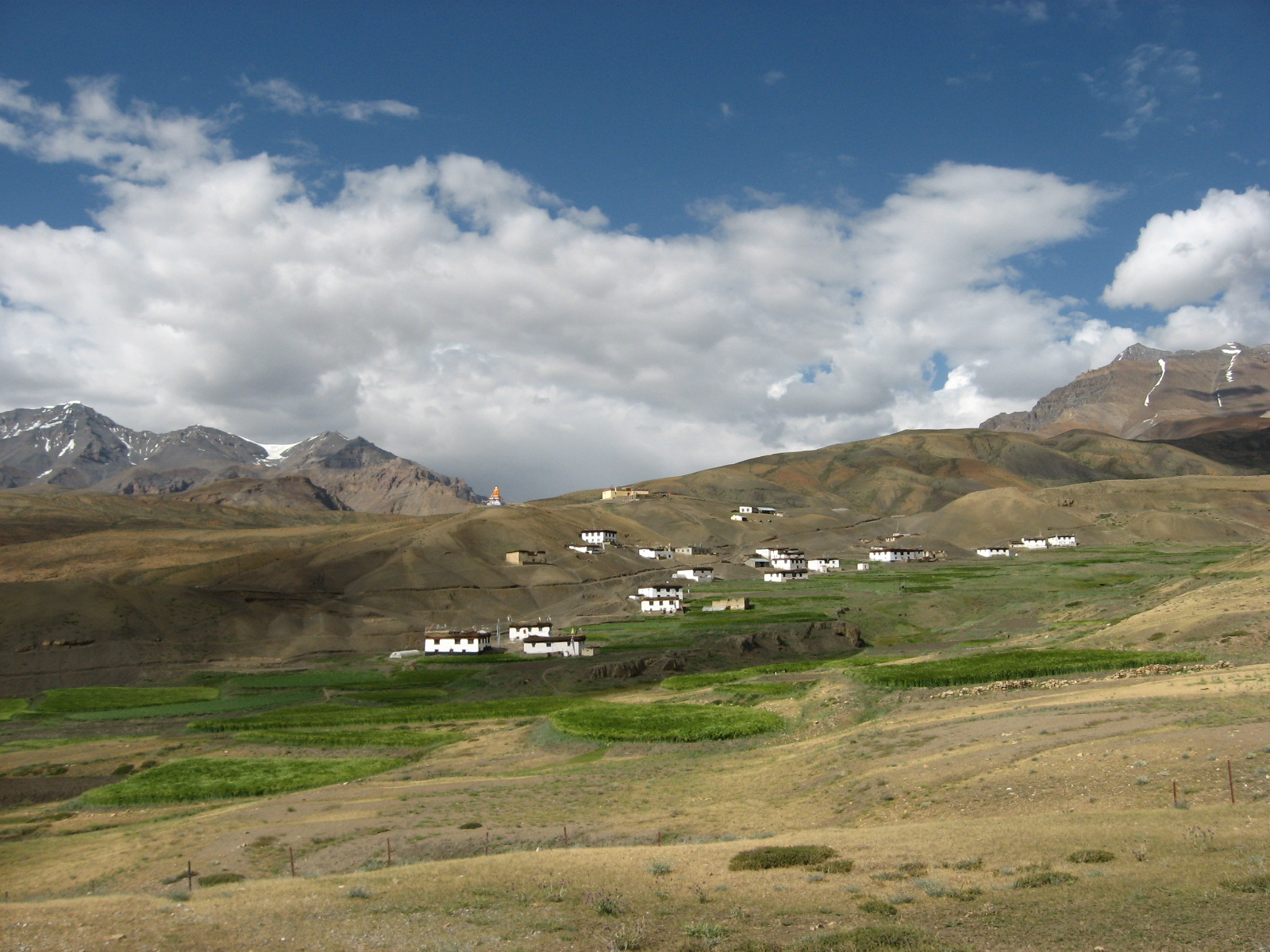Hikkim
Published on March 28, 2025
Nestled deep within the Spiti Valley, Hikkim is a village that feels like it’s been plucked straight out of a dream. Perched at an elevation of 4,400 meters (14,500 feet), this remote settlement holds the distinction of being home to the world’s highest post office , making it a bucket-list destination for travelers seeking unique experiences. Surrounded by barren mountains, glacial streams, and endless stretches of wilderness, Hikkim offers a surreal escape from the chaos of modern life.
The journey to Hikkim is as captivating as the destination itself. Winding roads through treacherous mountain passes like Kunzum La create a sense of anticipation and wonder. As you approach the village, the stark beauty of the desert-like terrain, dotted with traditional mud-brick houses and fluttering prayer flags, greets you with its raw charm. Known for its unspoiled landscapes and rich Buddhist heritage, Hikkim has remained relatively untouched by commercial tourism, making it a haven for those who crave authenticity over convenience. Let’s dive deeper into what makes Hikkim such a remarkable destination.

Why Hikkim Is Unlike Any Other Village
A Gateway to Solitude
Hikkim isn’t just another village—it’s a portal to serenity. With its high-altitude location and sparse population, the village offers a rare opportunity to disconnect from the noise of the world and reconnect with yourself. Whether you’re gazing at the endless expanse of barren mountains or listening to the whispers of the wind, every moment in Hikkim feels meditative.
The air here is crisp and thin, a constant reminder of the altitude. Breathing deeply, you’ll feel a strange clarity—as if the purity of the environment seeps into your soul. The silence is profound, interrupted only by the occasional bleat of a goat or the distant murmur of a prayer wheel turning in the breeze. For those overwhelmed by the hustle and bustle of urban life, Hikkim is a sanctuary where time slows down, and the mind finds peace.
Extreme Living: Life at 4,400 Meters
Living at such a high altitude comes with its own set of challenges, yet the people of Hikkim have thrived in this harsh environment for centuries. Their resilience and adaptability are nothing short of inspiring. From growing barley in rocky soil to surviving freezing winters, the villagers embody the spirit of endurance.
The houses in Hikkim are built using locally sourced materials like stone, clay, and wood. These structures are designed to withstand the region's extreme weather conditions, with flat roofs that double as storage spaces for fodder and crops. Inside, earthen stoves called bukharis provide warmth during the harsh winters, while thick walls insulate the interiors from the biting cold.
Despite the challenges, the villagers lead simple yet fulfilling lives. Their days revolve around agriculture, livestock rearing, and spiritual practices. Hospitality is ingrained in their culture, and visitors are often welcomed with open arms and warm smiles. Sharing a cup of butter tea with a local family is an experience that leaves a lasting impression—one of connection, warmth, and gratitude.

Unmissable Highlights of Hikkim
Sending a Postcard from the Edge of the World
Hikkim’s claim to fame is undoubtedly its world’s highest post office . Operated by India Post, this tiny establishment is more than just a postal service—it’s a symbol of human perseverance. Visitors can purchase postcards or stamps and send them to loved ones, knowing their letters will travel from one of the most extraordinary locations on Earth. It’s a small yet meaningful way to connect with the world while standing amid the majesty of the Himalayas.
The post office is run by a dedicated postmaster who braves the harsh winters and challenging terrain to ensure that mail reaches its destination. Despite the village’s remoteness, the post office operates year-round, albeit with limited hours during the winter months. Writing a postcard here is not just an act of communication but also a ritual of reflection. Many travelers take a moment to sit quietly, penning their thoughts against the backdrop of towering peaks and endless skies.
For those who love unique souvenirs, the postmark from Hikkim is a prized possession. It serves as a tangible reminder of your visit to one of the highest inhabited places on Earth—a memory you can hold onto forever.
The Fossil Trail: Walking Through Time
Hikkim is also home to ancient fossil beds, remnants of a time when this region was submerged under the Tethys Sea millions of years ago. These fossils, scattered across the landscape, offer a fascinating glimpse into Earth’s geological history. Walking along the fossil trail is like stepping into a natural museum, where every rock tells a story of evolution and change.
The fossils found here include ammonites, belemnites, and other marine creatures that once thrived in the ancient ocean. Some pieces are so well-preserved that you can see intricate details like spiral patterns and ridges. Locals often sell small fossil fragments as souvenirs, allowing visitors to take a piece of Hikkim’s history home with them.
Walking along the fossil trail is a humbling experience. It reminds us of the impermanence of life and the vastness of time. Standing amidst these relics of the past, you can’t help but feel a sense of awe at the forces that shaped our planet.

Experiencing Hikkim’s Unique Culture
Monastic Echoes: Spirituality in the Air
Hikkim is steeped in Buddhist traditions, and the local monastery serves as the spiritual heart of the village. Monks chant prayers, and the air is filled with the scent of incense and the sound of bells. Visitors are welcome to participate in daily rituals, offering a chance to immerse themselves in the tranquility of monastic life.
The monastery is adorned with colorful murals, thangkas (Buddhist paintings), and statues of deities. Prayer flags flutter in the wind, carrying blessings across the valley. Inside, the dimly lit halls exude a sense of calm, inviting visitors to sit quietly and reflect. For many, visiting the monastery becomes a transformative experience, leaving them with a deeper understanding of life and spirituality.
Festivals That Bring the Village Alive
Life in Hikkim revolves around festivals that celebrate nature, agriculture, and spirituality. One of the most significant events is Losar , the Tibetan New Year, which marks the beginning of the agricultural cycle. During this time, the entire village comes alive with music, dance, and elaborate rituals. Locals dress in colorful traditional attire, and the atmosphere is electric with joy and celebration.
Another notable festival is Halda , celebrated to honor the deity of fire. Villagers gather around bonfires, chanting hymns and performing folk dances under starlit skies. Participating in these celebrations allows travelers to immerse themselves in the rich tapestry of Spitian culture, forging connections that transcend language barriers.
These festivals are not just cultural events—they’re a testament to the community’s resilience and unity. They remind us of the importance of coming together to celebrate life, even in the harshest environments.

Adventure Awaits: Exploring Beyond Hikkim
Trekking to Komic: Pushing Your Limits
For adventure enthusiasts, the trek from Hikkim to Komic is a must-do. This challenging yet rewarding trail takes you through some of the most breathtaking landscapes in the Spiti Valley. Along the way, you’ll encounter barren deserts, glacial streams, and panoramic views of snow-capped peaks. Reaching Komic, the world’s highest motorable village, is a feat in itself and a testament to your endurance.
The trek begins with a gradual ascent through open meadows and rocky terrains. As you climb higher, the air grows thinner, and the views become more spectacular. The barren beauty of the landscape is both humbling and exhilarating, reminding you of nature’s raw power. Along the way, you might spot wildlife like Himalayan marmots or even the elusive snow leopard if you’re lucky.
Reaching Komic is a surreal experience. The village feels like the edge of the world, surrounded by towering peaks and endless silence. Spending a night here, under a blanket of stars, is an unforgettable experience that leaves you feeling connected to the universe.
Stargazing Under Infinite Skies
Hikkim’s high altitude and minimal light pollution make it one of the best places in the world for stargazing. On a clear night, the sky transforms into a canvas of twinkling stars, constellations, and even the Milky Way. For astronomy enthusiasts, this is a once-in-a-lifetime experience. Even casual observers will find themselves awestruck by the sheer vastness of the universe above.
The absence of artificial lights amplifies the brilliance of the night sky. Constellations like Orion, Cassiopeia, and the Big Dipper shine brightly, while shooting stars streak across the heavens. For those who bring telescopes or binoculars, the view is even more mesmerizing. You can spot planets like Jupiter and Saturn, their rings and moons visible as tiny specks of light.
Spending a night under the stars in Hikkim is a humbling experience. It reminds us of our place in the cosmos and fills us with a sense of wonder. Whether you’re lying on the ground, wrapped in a blanket, or sitting by a campfire, the night sky in Hikkim is something you’ll never forget.

Practical Tips for Visiting Hikkim
When to Visit: Timing Is Everything
The best time to visit Hikkim is during the summer months of May to September , when the weather is pleasant, and all roads are accessible. Autumn (October) offers stunning fall colors, while winter (November to April) transforms the village into a snowy wonderland—but be prepared for extreme cold and limited accessibility.
During the summer, temperatures range from 10°C to 20°C (50°F to 68°F) during the day, dropping significantly at night. Winters are harsh, with temperatures plummeting to -20°C (-4°F) or lower. If you plan to visit during the winter, ensure you’re well-prepared with warm clothing, sturdy boots, and emergency supplies.
Getting There: The Journey Is Part of the Adventure
Reaching Hikkim requires careful planning. The nearest major town is Kaza , about 20 kilometers away. From there, you can hire a taxi or take a shared jeep to Hikkim via the Kunzum Pass. The road is rugged and challenging, but the breathtaking views along the way make it worth every bump.
The drive to Hikkim is an adventure in itself. You’ll cross high-altitude passes, navigate narrow mountain roads, and pass through picturesque villages. Along the way, you’ll be treated to stunning views of snow-capped peaks, glacial rivers, and barren deserts. Keep your camera handy—the photo opportunities are endless!
If you’re traveling from Delhi or Manali, plan for a multi-day journey. The route involves crossing Rohtang Pass and Kunzum Pass, both of which are closed during the winter months due to heavy snowfall. Hiring a private vehicle ensures greater flexibility and comfort, especially if you’re traveling with family or friends.

Where to Stay: Embrace Local Hospitality
Accommodation options in Hikkim are limited but authentic. Homestays run by local families offer a chance to experience traditional Spitian life firsthand. You’ll sleep in cozy mud-brick houses, enjoy homemade meals, and share stories with your hosts around a warm fire.
Homestays typically include basic amenities like bedding, hot water, and meals. Don’t expect luxury—this is a rustic experience designed to immerse you in the local way of life. Meals are hearty and delicious, featuring traditional dishes like thukpa (noodle soup), momos (steamed dumplings), and siddu (steamed bread stuffed with walnuts or poppy seeds).
For those who prefer camping, several operators organize tented stays near the village. Imagine falling asleep to the sound of silence and waking up to the sight of snow-capped peaks—it doesn’t get better than this!
Why Hikkim Should Be on Your Travel List
Hikkim is more than just a destination—it’s an experience. From sending a postcard from the world’s highest post office to trekking through some of the most remote landscapes on Earth, every moment here is unforgettable. Whether you’re an adventurer, a culture enthusiast, or someone simply seeking peace, Hikkim has something for everyone.
The village’s isolation has preserved its pristine environment and traditional way of life. Visitors are often struck by the simplicity and warmth of the locals, who live in harmony with the harsh yet beautiful surroundings. Every interaction, every meal, and every step you take in Hikkim leaves a lasting impression.
So pack your bags, lace up your boots, and embark on a journey to this hidden gem in the Himalayas. Share your stories and inspire others to explore the magic of Hikkim!

Freqeuntly Asked Question About Hikkim
Where is Hikkim located and what makes it special?
Hikkim is a remote Himalayan village in Spiti Valley, Himachal Pradesh, perched at 4,400 meters (14,400 ft). It's world-famous for having the highest post office in the world (operating since 1983) and its ancient Buddhist culture.
What is the best time to visit Hikkim?
The ideal visiting window is June to September when temperatures range between 5°C to 15°C. October to May brings extreme cold (-15°C to -30°C) and road closures due to heavy snowfall.
Do I need any permits to visit Hikkim?
Indian citizens don't need permits, but foreign nationals require a Protected Area Permit (PAP) for Spiti Valley, obtainable in Shimla or Reckong Peo.
How do I reach Hikkim from Kaza?
Hikkim is just 14 km from Kaza (about 45-minute drive). The route passes through Langza village and offers spectacular mountain views. Shared taxis or private vehicles are available.
What are the must-do things in Hikkim?
-
Send a postcard from the world's highest post office
-
Visit the ancient Hikkim Monastery
-
Go fossil hunting (the area is rich in ancient marine fossils)
-
Stargazing (exceptionally clear night skies)
Is there mobile network or internet in Hikkim?
BSNL works intermittently; other networks have no coverage. There's no internet availability, making it perfect for a digital detox.
Are there accommodation options in Hikkim?
Basic homestays (₹800-1,200/night) are available, but most visitors stay in Kaza and visit Hikkim as a day trip due to limited facilities.
Can I visit Hikkim in winter?
Only for hardcore adventurers - December to March sees extreme cold (-25°C to -35°C) and snow-blocked roads. The post office remains open but with limited hours.
What makes Hikkim's post office unique?
Operating since 1983, this functional post office at 4,400m lets you send postcards with a special "World's Highest Post Office" cancellation stamp - a prized souvenir for travelers.
What should I pack for Hikkim?
-
Extreme cold weather gear (even summers are chilly)
-
Good hiking shoes for fossil hunting
-
Cash (no ATMs or card payments)
-
Power banks (electricity is solar-powered)
-
Basic medicines (nearest hospital is in Kaza)
